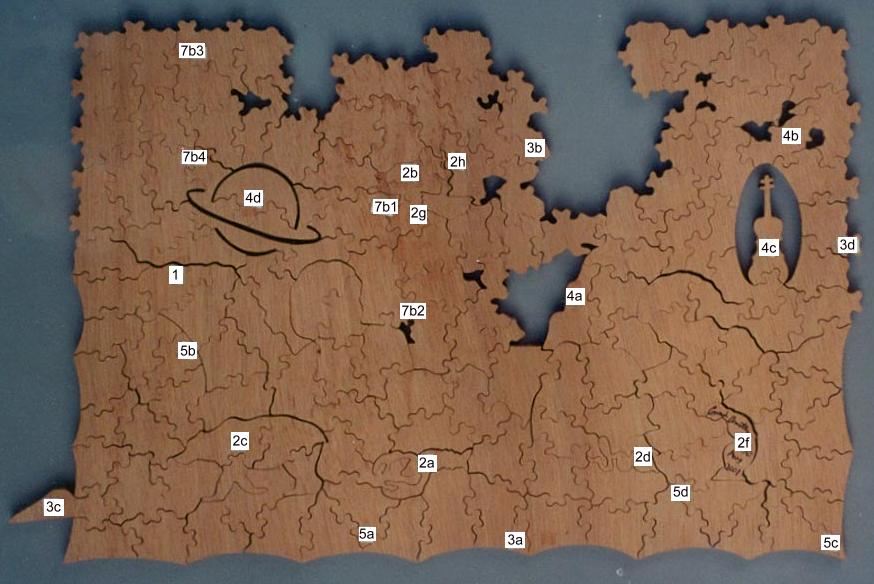Puzzle cut by Conrad Armstrong, 2001, to illustrate many of the special puzzle techniques described in my article.
Because the puzzle is so tightly and cleanly cut, the kerfs do not show well enough in the puzzle picture to illustrate all the techniques employed and so the puzzle has been photographed upside down with an identification code. At the time Conrad cut the puzzle, I had not completed my list of techniques, so several could not be incorporated . This leaves open the opportunity for some enterprising maker to cut a puzzle displaying even more special techniques. Good luck!


| Technique | Label | Comments |
|---|---|---|
| Color line cutting | 1 | Color-line cutting is used in may parts of this puzzle; but in particular, the tree area in the right half of the puzzle is separated from the rock and woman by color-line cutting (with occasional knobs to preserve interlock). |
| Figure pieces-normal | 2a | A simple lobster piece. |
| Figure pieces-enhanced | 2b | Not a spectacular example, but the bird’s wing is highlighted by a “dead-end” cut which is hard to see here. |
| Figure pieces-complex | 2c | The bear is cut into 4 pieces. |
| Figure pieces-personalized | 2d | This puzzle was cut for someone named Bob. |
| Figure pieces-signature | 2f | This cutter cuts a “strong arm” into all of his puzzles. |
| Figure pieces-appropriate | 2g | The bird and nest are situated on a branch in the tree. |
| Figure pieces-interactive | 2h | The bird is feeding a baby bird in a nest. |
| Irregular edges-not straight | 3a | A wavy (non-straight) edge. |
| Irregular edges-outline | 3b | The middle of the top edge comes into the puzzle to follow the outline of the trees. |
| Irregular edges-protrusion | 3c | A piece that protrudes beyond a regular edge confuses the assembler who expects the regular edge to continue. Note that a protrusion trick does not need to be used with a straight edge, just an edge that is “regular”; i.e., forms a pattern that the assembler expects to continue. |
| Irregular edges-knobs | 3d | A leafy tree section is a good place to use knobs on an edge. |
| Dropouts-enhancement | 4a | The sky area was dropped out, to be consistent with the sky area being left out because of the irregular edge. |
| Dropouts-deception | 4b | Many small areas in the tree where the sky was showing through were dropped out; assembling the pieces around these unexpected dropouts is very difficult. |
| Dropouts-figures | 4c | The violin shape is highlighted by framing it with a dropout. |
| Dropouts-sculpting | 4d | Three separate thin dropouts form the shape of a Saturn-like planet. |
| Disguised edges | 5a | There are actually 3 places in the regular edge where adjacent edge pieces do not interlock. |
| Inside edges, corners | 5b | Even though this puzzle has a non-straight edge, because it has a regular pattern-based edge, that pattern can be imitated by interior pieces, thus confusing the assembler. |
| Split corners | 5c | This is a common way of disguising corner pieces. |
| Split knobs | 5d | This puzzle has only one split knob. |
| Double cutting-deception | 7b1-2, 7b3-4 | The cut that extends from 7b1 down to 7b2 is exactly the same as the cut from 7b3 to 7b4; the pieces along the 7b1-7b22 cut can fit perfectly into the pieces along the 7b3-7b4 cut, but if that is done, other pieces around those areas will not fit in. |